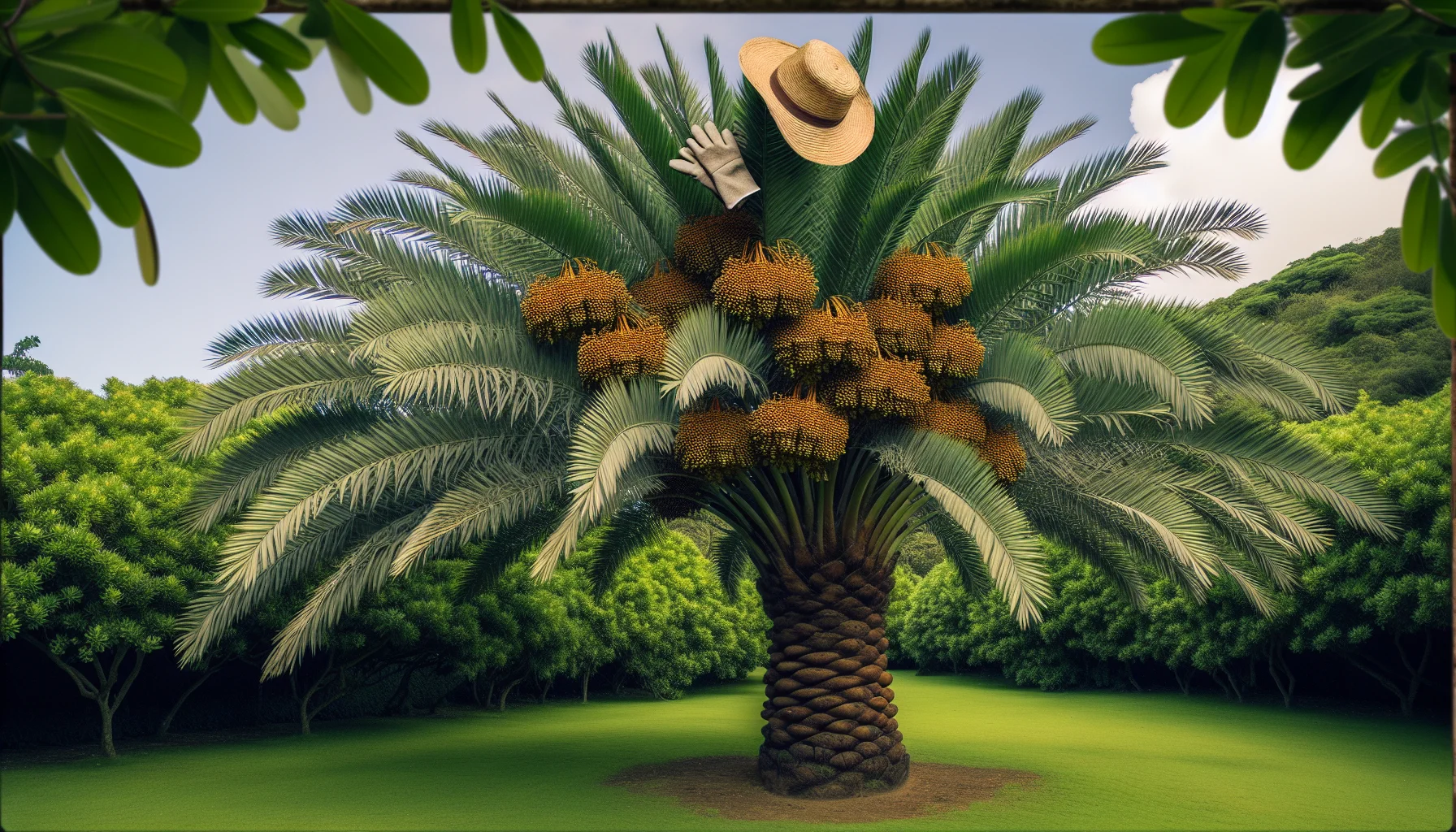Date palm tree Quiz
Test Your Knowledge
Question of
Introduction to Date Palm Trees
Date palm trees, scientifically known as Phoenix dactylifera, are a species of palm tree commonly recognized for their sweet fruit, dates. Originating from the Middle East and North Africa, these trees have been cultivated for thousands of years, not only for their nutritional fruits but also for their aesthetic appeal in landscaping and gardening. Date palms are a symbol of hospitality and peace in many cultures and play a significant role in the agricultural economy of date-producing countries. In gardening, they add a touch of exotic beauty, providing tall, elegant silhouettes and a lush canopy that offers shade and greenery to any landscape.
The History of Date Palms
Date palms, known scientifically as Phoenix dactylifera, have a rich history that dates back thousands of years, deeply intertwining with the growth and development of human civilizations across the Middle East, North Africa, and South Asia. Originating from lands around the Persian Gulf, these trees have been cultivated since ancient times, both for their sweet fruit and as a source of shade and material for building and handicrafts. Archaeological evidence suggests that date palm cultivation began as early as 6000 BCE in Mesopotamia, now modern-day Iraq, making it one of the oldest cultivated fruit trees in the world. Through centuries of trade and migration, the cultivation of date palms spread to Egypt, the Indus Valley, and eventually to the Roman Empire, where they became a symbol of prosperity and triumph. In many cultures, date palms are seen as a tree of life, representing fertility and immortality. Their history is not just a tale of agricultural success but also a testament to their significance in cultural and religious contexts across these regions.
Types of Date Palm Trees
- Medjool
- Barhi
- Dayri
- Halawy
- Khadravi
- Zahidi
How to Plant and Grow Date Palm Trees
Planting and growing date palm trees can be a rewarding endeavor, providing not only a beautiful addition to your garden but also the potential for delicious fruit. Here is a step-by-step guide on how to successfully plant and care for date palm trees in a garden setting.
Step 1: Choosing the Right Location
Date palm trees thrive in full sun and well-draining soil. Choose a location in your garden that receives at least 6-8 hours of direct sunlight daily. Ensure the planting site is away from buildings and other structures to accommodate the tree’s mature size.
Step 2: Soil Preparation
Date palms prefer sandy, loamy soil. If your soil is heavy clay or too compacted, amend it with sand and organic matter to improve drainage. The ideal pH level for the soil should be between 6 and 7. Test the soil pH and adjust accordingly.
Step 3: Planting the Date Palm
Plant your date palm in the spring or early summer when the soil is warm. Dig a hole twice as wide and just as deep as the root ball of your tree. Place the tree in the hole, making sure it’s standing upright, and backfill with soil. Water thoroughly after planting to settle the soil around the roots.
Step 4: Watering
Date palms require regular watering to establish their root systems. Water your tree deeply once a week, allowing the soil to dry out slightly between waterings. Reduce watering frequency as the tree matures, as date palms are drought tolerant.
Step 5: Fertilizing
Feed your date palm a balanced, slow-release palm fertilizer that contains micronutrients, especially during the growing season. Follow the manufacturer’s instructions for the correct dosage and application frequency.
Step 6: Pruning
Pruning is essential for maintaining the health and appearance of your date palm. Remove any dead or damaged fronds, as well as old fruit stalks, using clean and sharp pruning tools. Prune in the late winter or early spring before new growth begins.
Step 7: Pest and Disease Management
Keep an eye out for common pests such as spider mites and scale insects. Treat infestations promptly with appropriate insecticides or natural remedies. Also, ensure good air circulation around the tree to prevent fungal diseases.
By following these steps, you can successfully plant and grow date palm trees in your garden, enjoying their majestic beauty and, eventually, their sweet fruits. Remember, patience is key, as date palms can take several years to mature and produce fruit.
Common Pests and Diseases Affecting Date Palms
- Red Palm Weevil (Rhynchophorus ferrugineus) : A major pest that burrows into the trunk, causing severe damage. Prevention includes regular monitoring, avoiding injury to trees, and using pheromone traps.
- Bayoud Disease (Fusarium oxysporum) : A fungal disease that causes wilt and death in date palms. Prevent by using disease-free planting material and removing infected trees promptly.
- Dubas Bug (Ommatissus lybicus) : Feeds on the sap of the leaves, leading to reduced photosynthesis. Control through the use of oil sprays and maintaining tree health to resist damage.
- Leaf Spot Disease (Mycosphaerella spp.) : Causes spots on leaves which can lead to premature leaf drop. Manage by removing affected leaves and applying fungicides if necessary.
- Date Palm Mite (Oligonychus afrasiaticus) : These mites cause yellowing and necrotic spots on leaves. Control with miticides and by removing heavily infested leaves.
Benefits of Growing Date Palm Trees
Date palm trees, known for their lush, tropical appearance and sweet fruits, offer more than just aesthetic appeal to a garden. These majestic trees provide a myriad of environmental, aesthetic, and practical benefits that make them a valuable addition to any landscape.
From an environmental perspective, date palm trees play a crucial role in combating climate change. They are excellent at sequestering carbon dioxide, thus reducing the amount of this greenhouse gas in the atmosphere. Additionally, their dense foliage provides a habitat for various bird species, contributing to biodiversity. The trees also have a remarkable ability to tolerate high temperatures and drought conditions, making them an ideal choice for water-wise gardening in arid regions.
Aesthetically, date palm trees add a touch of exotic beauty to gardens. Their tall, slender trunks and gracefully arching fronds can create an instant tropical oasis feel, transforming an ordinary garden into a serene and inviting space. The shade provided by their broad canopies offers a cool retreat on hot summer days, enhancing the outdoor living experience.
On a practical level, growing date palm trees can be quite rewarding. They are relatively low maintenance, requiring minimal care once established. The trees are also productive, yielding delicious dates that can be eaten fresh, dried, or used in cooking and baking. This not only provides a sense of achievement but also contributes to a sustainable lifestyle by producing home-grown food.
In conclusion, incorporating date palm trees into a garden offers a host of benefits that extend far beyond their visual appeal. Whether for their environmental contributions, stunning appearance, or practical uses, date palm trees are a worthwhile investment for any gardener looking to enhance their outdoor space.
Frequently Asked Questions About Date Palm Trees
| Question | Answer |
|---|---|
| How often should I water my date palm tree? | Young trees need watering 2-3 times a week, while established trees require once a week, depending on the climate and soil conditions. |
| What type of soil is best for date palm trees? | Well-draining sandy loam soils with a neutral pH are ideal for date palm trees. |
| Do date palm trees need a lot of sunlight? | Yes, date palm trees thrive in full sunlight, requiring at least 6 hours of direct sunlight daily. |
| How do I fertilize a date palm tree? | Use a balanced, slow-release palm fertilizer with micronutrients, applying it during the growing season every 2-3 months. |
| Can date palm trees grow in cold climates? | Most date palm varieties prefer warm climates and are not frost-tolerant, though some can withstand brief cold down to about 20°F (-6°C). |
| How long does it take for a date palm to produce fruit? | It can take 4-8 years for a date palm to begin producing fruit, depending on the variety and growing conditions. |
| What are the benefits of having a date palm tree? | Beyond fruit production, date palms provide shade, add aesthetic value to landscapes, and can help reduce noise pollution. |












